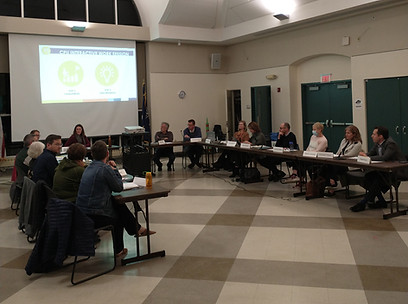Comprehensive Plan Update &
Local Waterfront Revitalization Program (LWRP)


ABOUT THE PROJECT
Project Overview
The Village of Hastings-on-Hudson has initiated an update to their Comprehensive Plan as well as the development of a Local Waterfront Revitalization Program (LWRP). The Village intends to undertake and complete the two plans simultaneously and in parallel. The planning process will involve stakeholders from the Village including municipal officials, Village Trustees, community organizations, businesses and residents to help the community identify challenges and opportunities.
Scroll through this page to learn more about the Comprehensive Plan Update, LWRP, and who is involved in the process!
What is a Comprehensive Plan?
A Comprehensive Plan is both a a long-term community vision for the future and a blueprint for how to get there. The Comprehensive Plan document will create a framework for the future for a range of topic areas including but not limited to land use, economic development, infrastructure, and housing. The Comprehensive Plan will evaluate the existing conditions of the community (existing state); identify a vision for the future (desired state), and outline a series of recommendations and steps to achieve that vision (implementation).

What is an LWRP?
An LWRP was previously drafted by the Village in 2007 but was not formally adopted. An LWRP is a comprehensive land and water use program that expresses a long-term vision for the future of the waterfront revitalization area, which is proposed as the entire Village area. An LWRP also provides the means to achieve that vision through the identification of regulations and recommendations that will guide future development and infrastructure improvements. An LWRP is also a regulatory tool to ensure that local, state, and federal actions in the waterfront revitalization area are consistent with the forty-four state coastal policies, and to facilitate cooperation at multiple levels of government.
Purpose
The purpose of an LWRP is to plan for long term land and water uses for the local waterfront area (Village) and specify legal techniques for implementation. These regulations will be designed to implement a clear overall concept of how the community's waterfront should be used. The regulations may include but are not limited to guiding development to areas with adequate infrastructure and services away from sensitive resources, promoting public waterfront access, and providing for redevelopment of underutilized waterfronts.
Process
PLAN - LWRPs begin with a planning process that centers on developing a vision for the future of the waterfront revitalization area (Village). The planning process will be a consensus-driven effort which includes a robust public engagement component to gather input from residents, visitors, business owners, property owners, and other stakeholders in the community. Your participation in this process is vital!
EXECUTE - LWRPs are approved on three levels of government through local adoption; Secretary of State approval; and federal concurrence from NOAA’s Office of Coastal Management for coastal LWRPs.
IMPLEMENT - Once an LWRP is approved and in place, municipalities are eligible for implementation funds through multiple state and federal agencies. Communities are well positioned to receive funding for implementation of priority projects with a completed LWRP.
Benefits
There are a host of community benefits to completing an LWRP. These include but aren't limited to:
-
Clear, consensus driven direction for the future of the waterfront
-
Establishment of long-term state-local partnerships for planning, technical assistance and advice.
-
Review of government agency actions that affect the local waterfront area.
-
Increased opportunities to apply for financial assistance from State funding sources to implement the LWRP.
-
Mary Beth Murphy, Village Manager
-
Trustee Drake, Village Trustee
-
Trustee Fleisig, Village Trustee
-
Ray Dovell, Committee Chair
-
Chris Thomas
-
Dave Gunton
-
Edward Kuch
-
John Patrick Diggins
-
Meg Walker
-
Meghann Donahue
-
Natalie Barry
-
Richard Bass
-
Samantha Merton
-
Sarah Dupere Ostro

CPU & LWRP Committee
A Comprehensive Plan Update and LWRP Committee has been appointed by the Board of Trustees to guide the planning process. Read more about the Committee on the Village webpage.
The planning process will be facilitated by Village staff and a consultant team led by M.J. Engineering and Land Surveying, P.C. and supported by Adropogon Associates, E.M. Pemrick & Company, and Shumaker Engineering.
What are Smart Growth Principles
how are they relevant to this process?
Smart Growth is an approach to community planning and development that integrates what are known as the “3 Es”—Economy, Equity and Environment, with an emerging fourth E—Energy. Smart Growth promotes several land use planning principles that create livable, sustainable and equitable communities.
When adopted, the Village's Comprehensive Plan update must address and incorporate the following general Smart Growth principles, in addition to the elements suggested by the New York State statutes:
-
Promote mixed land uses in focus areas
-
Create an adequate range of housing opportunities and choices
-
Promote development and redevelopment where infrastructure is adequate and sustainable
-
Build on traits that make a distinctive and attractive community with a strong sense of place
-
Promote well-planned and well-placed public spaces
-
Promote sustainable compact neighborhoods
-
Increase mobility and circulation within jurisdictional lines and improve connectivity with areas outside jurisdictional lines
-
Promote sustainable mass transit that reduces the local levels of greenhouse gas emissions
-
Promote walkable/bikeable neighborhood designs
-
Promote and integrate clean energy resources and related incentives
-
Improve green infrastructure and resident’s participation to this effort
-
Increase resiliency to extreme weather events
-
Encourage social diversity and integration
-
Expand planning and implementation efforts across jurisdictional lines, to increase effectiveness, sustainability, and resiliency
-
Promote community and stakeholder collaboration in planning
